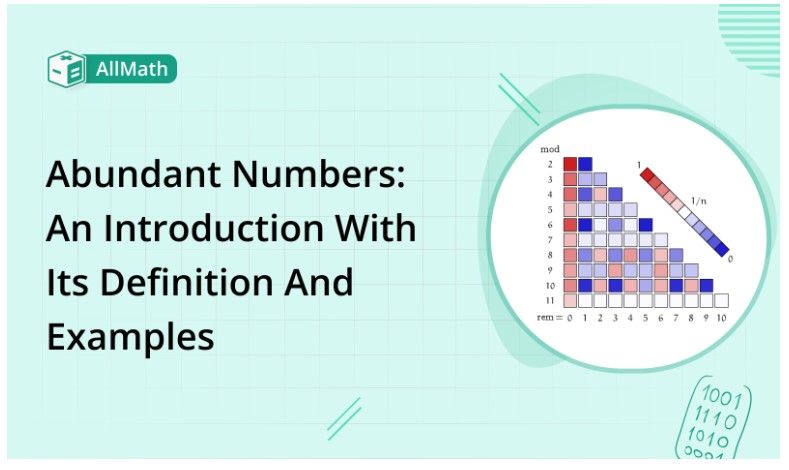To calculate result you have to disable your ad blocker first.
Abundant Numbers: An Introduction with its Definition and Examples

Publish Date: 08 Aug, 2023
Table of Content
The abundant number is a topic of number theory in mathematics with a rich history dating back to ancient times. The concept of abundant numbers was first studied by the Greeks, who were interested in finding and classifying different types of numbers.
Throughout history, mathematics has been fascinated by the properties of abundant numbers and has studied them in depth. In the Middle Ages, the study of abundant numbers was closely linked to the study of perfect numbers, and many important discoveries were made in this era.
In this article, we elaborate on the concept of abundant numbers, its properties, some useful applications, and examples.
What is the Abundant Number?
In number theory, “an abundant number is a positive integer that is smaller than the sum of its proper divisors. The proper divisors of a number are all its positive divisors excluding itself”. In other words, “an abundant number n is one for which the sum of its proper divisors is greater than n”.
Examples:
- The number 12 is abundant because its proper divisors (
1, 2, 3, 4, and 6) add up to 16, which is greater than 12. - The number 8, on the other hand, is not abundant, because its proper divisors (
1, 2, and 4) add up to 7, which is less than 8.
Properties of Abundant Number
Abundant numbers have many interesting properties and relationships with other types of numbers but only some important ones are discussed here:
- An abundant cannot be prime, because the sum of the proper divisor of a prime number is always 1. Its mean abundant number is always composite.
- Every odd abundant number is a multiple of 3. This is because the sum of the proper divisors of an odd number that is not
divisible by 3is always odd, which means it cannot be abundant. - The set of abundant numbers is infinite.
- If n is abundant, then every multiple of n is also abundant. This is because the proper divisors of k*n (where k is an integer) are just the divisors of n multiplied by k.
- Every abundant number can be written as a product of distinct prime powers, and this factorization is unique up to the order of factors.
Applications of Abundant Number
Here are some applications of abundant numbers in mathematics mostly have many interesting:
- Due to their abundance, the property of numbers being difficult to factorize into prime factors is used in cryptographic algorithms.
- Abundant numbers are also used in the composition of interesting and unique patterns of music due to its rich and complex structure.
- Abundant numbers are an important area of study in number theory, and many famous mathematicians have made significant contributions to this field.
- Abundant numbers are also used in the computer science field such as in the analysis of algorithms and the design of data structures.
The process of finding an Abundant Number
To find whether a number is abundant or not, one can follow the below procedure:
- Take an integer as input
- Find all its divisors except itself
- Add up all the divisors
- Compare the sum of divisors with the original number.
- If the sum of the divisors is greater than the original number, then the number is abundant.
- If the sum of the divisors is less than the original number, then the number is deficient.
- If the sum of the divisors is equal to the original number, then the number that is neither abundant nor deficient is known as the perfect number.
This is the simplest and easiest way to find out whether a number is abundant or deficient.
Examples of Abundant Number
Example 1:
Find whether 14 is an abundant or deficient number.
Solution:
Step 1: Take an integer as input
Number = 14
Step 2: Find all divisors except itself
Divisors of 14 = 1, 2, and 7
Step 3: Add up all divisors
1 + 2 + 7 = 10
Step 4: Compare the sum of divisors with the original number.
14 > 10
It is clear that the sum of all divisors is less than the original number, so, the given number 14 is deficient.
Example 2:
Find whether 6 is an abundant or deficient number.
Solution:
Step 1: Take an integer as input
Number = 6
Step 2: Find all divisors except itself
Divisors of 6 = 1, 2, and 3
Step 3: Add up all divisors
1 + 2 + 3 = 6
Step 4: Compare the sum of divisors with the original number.
6 = 6
It is clear that the sum of all divisors is equal to the original number, so, the given number 6 is the perfect number.
Example 3:
Find whether 48 is an abundant or deficient number.
Solution:
Step 1: Take an integer as input
Number = 48
Step 2: Find all divisors except itself
48 = 1, 2, 3, 4, 6, 8, 12, 16, and 24
Step 3: Add up all divisors
1 + 2 + 3 + 4 + 6 + 8 + 12 + 16 + 24 = 76
Step 4: Compare the sum of divisors with the original number.
48 < 76
It is clear that the sum of all divisors is greater than the original number, so, the given number 48 is the abundant number.
Conclusion
The study of abundant numbers is a testament to the beauty and complexity of mathematics. As we continue to explore the mysteries of the mathematical universe, abundant numbers will undoubtedly continue to play a significant role in shaping our understanding of numbers and their properties.

